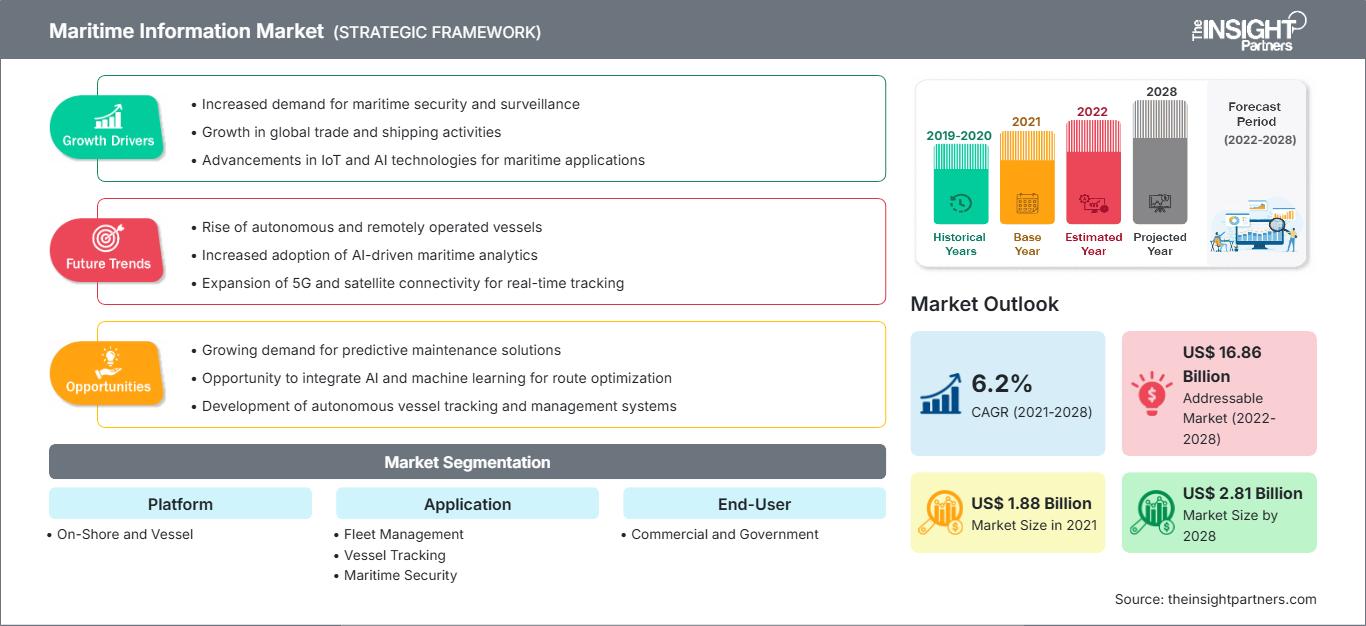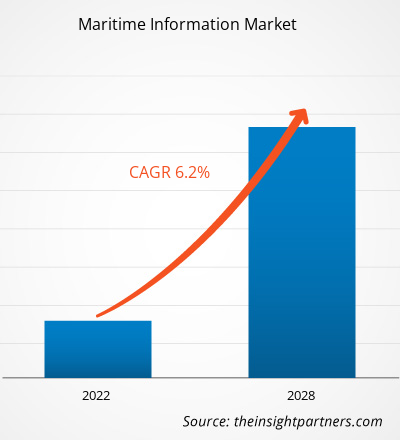2021年,海事信息市场规模达18.8201亿美元,预计2022年至2028年的复合年增长率为6.2%。
海运业的数字化转型使用户能够收集有关海军舰艇所有权、航行动态、规格和商业活动的重要信息。海事信息解决方案通过监测多种参数帮助船舶适应恶劣海况,从而使用户能够做出更好的战略和运营决策。此外,这些解决方案还能提高生产力和整体安全性,同时确保海上作业的效率。这些因素正在扩大海事信息市场的规模。
海事信息解决方案在确保经济安全方面发挥着重要作用;因此,这些解决方案被世界各地的政府机构广泛采用。这些解决方案帮助各国减少人口贩运、恐怖袭击、环境破坏和海上非法移民等海上威胁。此外,由于世界贸易自由化,跨洋船舶数量显著增加,这推动了对这些解决方案的需求。此外,国际海事组织 (IMO) 已要求所有船舶必须配备自动识别系统 (AIS),以监控船舶交通并避免与其他船舶发生碰撞。此外,航运业制造商正在资助研发活动,以实现准确探测海军舰艇信号的能力。这些因素正在扩大海事信息市场的规模。
随着海上交通量的增加,提高船舶安全性和保护船舶环境已变得至关重要。例如,根据印度港口部门的数据,2020 年印度主要港口的货运量为 4.142 亿吨,与 2020 年第一季度相比,2021 年增长了 12.9%。此外,信息交流鼓励航运业供应链的各个环节共同努力,确保平稳运行。具有船舶交通监控功能和有效跟踪系统的集成系统(例如 AIS 和合成孔径雷达 (SAR))对于船舶而言至关重要,这有助于海事信息市场的增长。
自定义此报告以满足您的要求
您将免费获得任何报告的定制,包括本报告的部分内容,或国家级分析、Excel 数据包,以及为初创企业和大学提供超值优惠和折扣
海事信息市场: 战略洞察

-
获取本报告的主要市场趋势。这个免费样本将包括数据分析,从市场趋势到估计和预测。
在海事信息市场运营的一些主要公司包括国际海事卫星组织 (Inmarsat)、L3 Harris Technologies、ORBCOMM、雷神公司、泰雷兹集团、exactEarth 和铱星通信公司。例如,2022 年 4 月,Spire Global 推出了面向海事行业的气象信息解决方案。该公司通过全面部署的 100 多颗卫星星座收集全球气象数据,这些卫星能够覆盖包括公海在内的偏远地区,而这些地区一直以来都难以观测。 Spiers 通过机器学习和人工智能将气象数据与海洋专业知识相结合,提供气象洞察,帮助客户节省时间和成本。
2022 年 9 月,BAE 系统公司宣布计划在 2024 年前将首个多传感器卫星群发射到近地轨道,以便从太空向军事客户实时提供高质量的海事信息和情报。
新冠疫情对海事信息市场增长的影响
新冠疫情对海上贸易和运输造成了长期影响。港口、航运运营和供应链都受到了疫情相关限制的不利影响。原材料短缺、交货时间问题、停航、港口关闭、港口开放时间缩短、设备和劳动力短缺以及运输能力限制只是船舶运营商在危机期间面临的一些困难。这些障碍严重损害了运输服务,并危及供应链和贸易往来的平稳运行。多个国家和地区的航运业发布了与 COVID-19 危机相关的多份港口海事通函。
为控制 SARS-CoV-2 的传播,各国政府实施了旅行限制并关闭了边境。港口和机场因此关闭。全球约 90% 的贸易通过海上运输。此外,各国政府实施的保持社交距离措施导致港口当局限制船舶运营,从而减少了对海事信息和分析解决方案的需求。然而,随着 2021 年封锁的解除和疫苗接种的成功,许多公司已经恢复运营,旅行限制的放宽帮助航运业重获发展势头。因此,2021 年全球对海事信息解决方案的需求有所增加。
市场洞察 –海事信息市场
高效管理复杂供应链运营的需求
航运业正在拥抱数字化,以提高效率、打造更智能的船舶和船队,并为全球贸易扩张做好准备。随着消费需求的增长,全球供应网络正在不断扩展,并变得越来越复杂。航运企业需要不断努力并实施新的战略,以在竞争激烈的全球市场中最大限度地提高效率并简化供应链。人工智能、区块链、物联网和自动化等创新技术与航运运营的融合,使得库存数据整理、船舶跟踪和管理、信息追踪以及电子发票生成变得轻松便捷。利用这些技术,航运企业可以减少在运输、接收、跟踪和收集订单数据上花费的时间。这些技术有助于开发新的商业前景,并转型供应网络。最终用户可以利用设计和仿真工具、仓库管理、运输和堆场管理以及借助海事信息进行端到端物流网络控制,从而成功地管理供应链活动。此外,更严格的环境法规持续影响着海上运输业,因为运输商必须节省成本并确保运营的可持续性。因此,对高效管理复杂供应链运营的需求日益增长,推动了海事信息市场份额的增长。
基于平台的洞察
海事信息市场根据平台、应用和最终用户进行细分。基于平台,海事信息市场分为岸上市场和船舶市场。船舶市场在2021年占据了更大的市场份额。在海事信息市场运营的公司为能够服务于各种复杂海洋项目的海上船舶船队提供一系列海事解决方案和服务。现代船队采用新技术、高效的推进系统和久经考验的可靠性,可提供广泛的服务,例如海底施工和拖带作业。船队船舶数量的不断增长,对用于船舶运营和管理的先进海事信息软件和服务的需求不断增加,从而推动了市场的增长。
海事信息市场
The Insight Partners 的分析师已详尽阐述了预测期内影响海事信息市场的区域趋势和因素。本节还讨论了北美、欧洲、亚太地区、中东和非洲以及南美和中美洲的海事信息市场细分和地理位置。
海事信息市场报告范围
| 报告属性 | 细节 |
|---|---|
| 市场规模 2021 | US$ 1.88 Billion |
| 市场规模 2028 | US$ 2.81 Billion |
| 全球复合年增长率 (2021 - 2028) | 6.2% |
| 历史数据 | 2019-2020 |
| 预测期 | 2022-2028 |
| 涵盖的领域 |
By 平台
|
| 覆盖地区和国家 |
北美
|
| 市场领导者和主要公司简介 |
|
海事信息市场参与者密度:了解其对商业动态的影响
海事信息市场正在快速增长,这得益于终端用户需求的不断增长,而这些需求的驱动因素包括消费者偏好的演变、技术进步以及对产品优势的认知度的提升。随着需求的增长,企业正在扩展其产品线,不断创新以满足消费者需求,并利用新兴趋势,从而进一步推动市场增长。

- 获取 海事信息市场 主要参与者概述
海事信息市场的参与者主要致力于开发先进高效的产品。
- 2021年10月,全球空间数据和分析提供商Spire Global, Inc.宣布推出Maritime 2.0,这是Spire海事解决方案的更新版本,可提供有关船舶位置、天气状况和全球航运活动组织的海事数据,从而优化实时决策。
- 2022年9月,铱星通信公司(Iridium Communications Inc.)披露,领先的海事建筑和土木工程公司Jan De Nul Group已选择铱星的全球海上遇险和安全系统(GMDSS)解决方案。通过采用铱星GMDSS,Jan De Nul坚持为其员工提供尽可能安全的工作环境的承诺。
海事信息市场根据平台、应用程序和最终用户进行细分。基于平台,市场分为岸上市场和船舶市场。根据应用,市场细分为船队管理、船舶追踪和海事安全。根据最终用户,市场分为商业和政府。
海事信息市场分为五大区域——北美、欧洲、亚太地区 (APAC)、中东和非洲 (MEA) 和南美 (SAM)。2021 年,欧洲以可观的收入份额领先市场,其次是北美和亚太地区。海事信息市场分析有助于了解即将到来的趋势、新技术以及预计将影响未来几年市场增长的宏观和微观因素。
公司简介:
- BAE Systems Plc
- Spire Global
- Iridium Communications Inc
- L3Harris Technologies Inc
- Lockheed Martin Corp
- ORBCOMM Inc
- Saab AB
- Thales Group
- Windward Ltd
- Northrop Grumman Corp
- Polestar
- Oneocean
- Fujitsu Limited
- Siemens AG
- 历史分析(2 年)、基准年、预测(7 年)及复合年增长率
- PEST和SWOT分析
- 市场规模、价值/数量 - 全球、区域、国家
- 行业和竞争格局
- Excel 数据集
近期报告
客户评价
购买理由
- 明智的决策
- 了解市场动态
- 竞争分析
- 客户洞察
- 市场预测
- 风险规避
- 战略规划
- 投资论证
- 识别新兴市场
- 优化营销策略
- 提升运营效率
- 顺应监管趋势






















 获取免费样品 - 海事信息市场
获取免费样品 - 海事信息市场